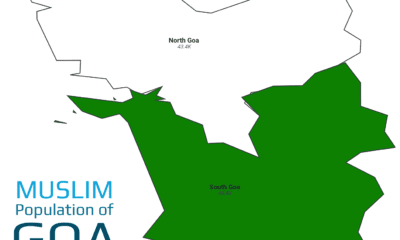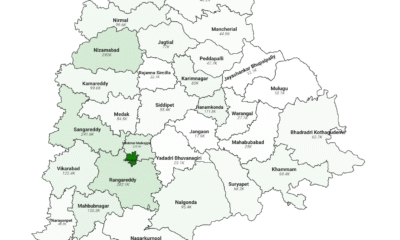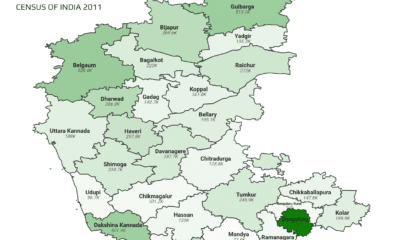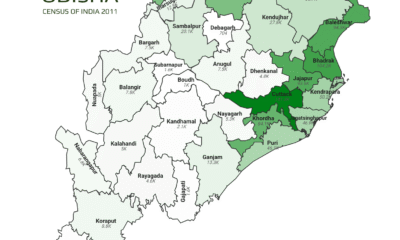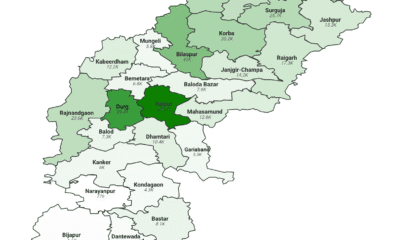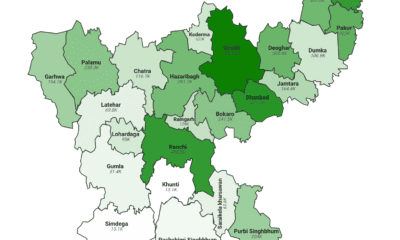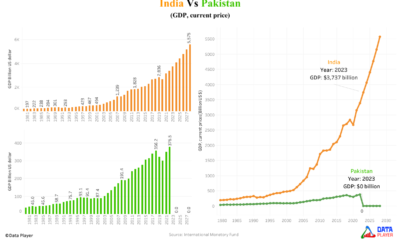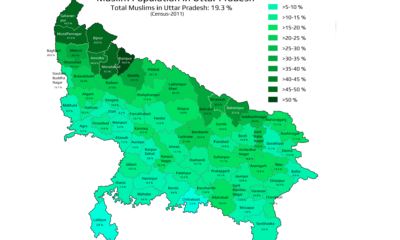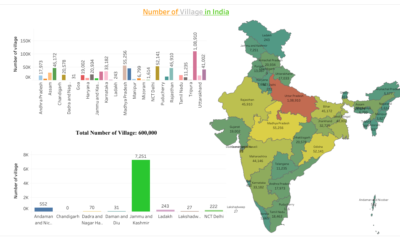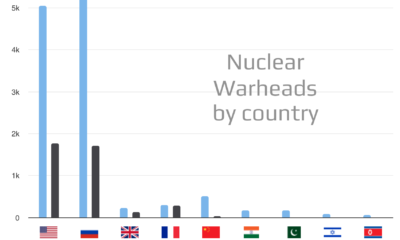Published
3 months agoon
Madhya Pradesh, a large and centrally located state in India, has a significant and regionally varied Muslim population—approximately 4.77 million people, comprising 6.57% of the total population, as per the 2011 Census of India[1]. Muslims are unevenly distributed, with higher concentrations in urban districts such as Bhopal (22.16%), Ujjain (11.73%), Shajapur (13.96%), Indore (12.67%), and Dewas (11.14%), as well as in parts of western Madhya Pradesh like Mandsaur (9.37%) and Ratlam (10.38%).
The Muslim community in Madhya Pradesh is predominantly Sunni, with a modest presence of Shia populations in urban centers. Urdu is widely spoken within the community, alongside Hindi and local dialects like Malwi, Bundeli, and Nimadi, reflecting the linguistic diversity of the state. The historical legacy of Muslim rule during the Mughal and Nawabi periods has influenced architecture, cuisine, and Sufi practices, especially in cities like Bhopal, which was once a princely state under Muslim rulers[2].
Economically, Muslims in Madhya Pradesh are active in trades such as textiles, footwear, metalwork, and food services. Many run small retail outlets, repair shops, and traditional craft businesses. However, the community also faces challenges related to poverty, limited access to capital, and underrepresentation in formal employment sectors. Disparities are more visible in smaller towns and rural areas, where infrastructure and access to education remain limited.
In terms of education, the Muslim literacy rate in the state (70.3%) is below the state average (69.3% male and 56.1% female for Muslims), but cities like Bhopal and Indore have seen progress due to the rise of minority-focused schools, scholarship programs, and educational NGOs. Efforts to improve outcomes for Muslim youth—especially girls and first-generation learners—are slowly gaining ground through targeted government schemes and community initiatives [3].
Madhya Pradesh has a sizable and regionally varied Muslim population spread across urban and rural districts. According to the 2011 Census, Bhopal has the highest number of Muslims in the state—463,000, making up 22.16% of the district’s population. Indore follows with around 374,000 Muslims (12.67%), while Ujjain has approximately 232,000 Muslims (11.73%). Other districts with significant Muslim populations include Shajapur (156,000, 13.96%), Dewas (164,000, 11.14%), Ratlam (156,000, 10.38%), and Mandsaur (147,000, 9.37%).
These urban centers have visible and active Muslim communities engaged in retail, skilled trades, education, religious services, and food industries. In places like Bhopal and Indore, mosques, madrasas, and Muslim-owned shops are integral parts of the urban landscape. The community contributes meaningfully to both cultural heritage and the economy.
However, challenges remain, especially in educational attainment, employment opportunities, and housing access. Despite these issues, Muslims in Madhya Pradesh continue to play a vital role in shaping the state’s social and economic fabric.
In Madhya Pradesh, the percentage of Muslims differs greatly from one district to another. Bhopal has the highest proportion, with 22.16% of its population being Muslim, making it the most Muslim-majority district in the state. It is followed by Shajapur (13.96%), Indore (12.67%), Ujjain (11.73%), and Dewas (11.14%)—all urban or semi-urban centers with a rich Islamic cultural presence. Burhanpur (10.50%) and Ratlam (10.38%) also show significant Muslim shares.
These areas are known for active Muslim participation in commerce, religious education, food industries, and service sectors. Cities like Bhopal and Indore have dense Muslim neighborhoods with mosques, madrasas, tailoring businesses, and Halal meat markets as key community features.
Rural districts like Mandsaur (9.37%) and Khandwa (8.97%) also have sizable Muslim populations. While urban centers show higher percentages, Muslims in Madhya Pradesh contribute meaningfully to both economic activity and social diversity, especially in top-percentage districts.
In Madhya Pradesh, some districts have a much smaller Muslim population compared to others. Anuppur has the lowest percentage, with just 1.56% of its population identifying as Muslim. This is followed by Umaria (1.75%), Sidhi (1.83%), and Singrauli (2.03%). Other low-percentage districts include Dindori (2.26%), Shahdol (2.29%), and Mandla (2.43%). These districts are largely tribal or forested regions in eastern Madhya Pradesh, where Hindu and Adivasi communities form the majority.
Muslim communities in these areas are small and often concentrated in limited pockets. There are fewer mosques, madrasas, or Muslim-run institutions, but the community still maintains its religious and cultural practices. Economically, many Muslims here are involved in small-scale retail, manual work, or service industries, often integrated into local markets. Despite their smaller numbers, they remain active in local economic and religious life, contributing to the diversity of the state’s social fabric.
1. Bhopal
Bhopal district has a Muslim population of around 525,434, accounting for 22.16% of its total 2,371,061 residents. Urdu and Hindi are commonly spoken in the community, with many also understanding Marathi due to local influences. The Muslim community is a vital part of Bhopal’s economic life, active in trade, education, and local governance. Given its strong institutional base, further growth and cultural visibility are expected in the urban and peri‑urban zones.
2. Indore
Indore hosts about 415,142 Muslims, making up 12.67% of a total of 3,276,697 people. The predominant languages are Hindi and Urdu, with dialects like Malwi in informal settings. Muslims in Indore are prominent in textiles, retail, and education. The community benefits from urban infrastructure, thriving madrasa networks, and emerging youth-led enterprises. Continued growth is likely as educational attainment and economic participation expand.
3. Ujjain
In Ujjain, 233,133 Muslims constitute 11.73% of a 1,986,864 population. Urdu and Hindi are widely spoken, along with regional Nimadi dialects. The Muslim presence here centers on small businesses, religious tourism services, and educational initiatives. With Ujjain’s cultural heritage and growing connectivity, the community’s economic role is gradually rising—especially through hospitality and schooling linked to pilgrimage and local tourism.
4. Shajapur
Shajapur district includes 131,440 Muslims, about 13.96% of its 941,403 population. Hindi and Urdu are widely used, while local Malwi dialects feature in daily life. Muslim residents engage primarily in agriculture support services, small trade, and food processing. Despite being rural-dominant, improved access to education and vocational training is enabling moderate community uplift—particularly among younger generations looking for non-farming livelihood options.
5. Dewas
Dewas has 174,259 Muslims, representing 11.14% of its 1,563,715 residents. The community typically uses Hindi and Urdu, with occasional Nimadi usage. Muslims in Dewas are active in commerce, transport services, and education. Emerging small enterprises and community-run schools have begun boosting socio-economic outcomes. Continued improvements in literacy and market access point towards steady demographic and cultural engagement in urban and rural zones alike.
6. Ratlam
Ratlam district features 151,071 Muslims, which is 10.38% of a 1,455,069 population. Urdu and Hindi are common; Nimadi and Malwi dialects are also heard. The Muslim community is engaged in trade, agriculture-related commerce, and small manufacturing. Connectivity to neighboring Gujarat aids remittances and technical skills exchange. This cross-border exposure supports gradual growth in education and upward mobility among younger residents.
7. Mandsaur
Mandsaur counts 125,548 Muslims, comprising 9.37% of a 1,340,411 population. Hindi and Urdu are the main languages, with occasional Malwi dialect use. Muslim community members work in seed trade, agriculture services, retail, and education. Expansion of community schools and vocational centers is helping bridge gaps. Young people are increasingly entering skilled trades and transport sectors, indicating growth in both employment and enterprise.
8. Neemuch
Neemuch has 67,324 Muslims, making up 8.15% of its 826,067 population. Urdu and Hindi are primary; Malwi dialects appear in casual use. Muslims in Neemuch participate in transport, agriculture markets, and small businesses. The presence of military and trade infrastructure offers opportunities. Youth engagement in education and coaching centers is rising, bolstering prospects for better economic participation and social integration in coming years.
9. Vidisha
Vidisha district has 149,548 Muslims, accounting for 10.25% of its 1,458,875 population. Urdu and Hindi are commonly used; Bundeli dialects are also prevalent. Muslim residents contribute through trade, retail, and religious education. The proximity to Vidisha’s historic and archaeological sites supports tourism-related opportunities. Expanding access to schooling and small business credit indicates gradual socio-economic advancement for the Muslim community.
10. Sagar
Sagar district comprises 103,480 Muslims, or 4.35% of its 2,378,458 population. Urdu and Hindi remain familiar, with Bundeli dialects frequently used. Muslims here engage in service work, education support, and local retail sectors. The smaller percentage limits institutional presence, but community-led madrasas, minority scholarships, and urban migration have begun improving involvement—especially among Sagar town’s Muslim youth.
11. Rewa
Rewa district has 76,154 Muslims, comprising 3.52% of its total 2,163,676 population. Hindi and Urdu are common, with Bagheli dialects used informally. Muslims here primarily engage in small retail businesses, teaching, and skilled trades. Educational infrastructure is modest, though increasing access to scholarships and online resources is encouraging youth participation. Rewa’s urbanizing landscape may enable better opportunities, but disparities between urban and rural areas persist for the community.
12. Satna
Satna has a Muslim population of 62,976, making up 3.78% of 1,665,824 people. Urdu, Hindi, and Bagheli are widely spoken. Muslims contribute to construction, transportation, and local trade sectors. In Satna town, mosques and community-run schools are focal points for cultural identity. Despite the small percentage, community ties remain strong, and digital literacy among youth is improving educational outcomes slowly. Migration to urban centers is also a growing trend.
13. Jabalpur
Jabalpur’s Muslim population is 268,947, or 11.29% of its 2,381,259 total. Urdu and Hindi are prevalent, and the district is home to well-established Muslim neighborhoods. The community is visible in wholesale markets, education, transport services, and skilled employment. Jabalpur’s strong infrastructure enables better schooling and healthcare access, though challenges remain in housing and employment equity. With rising urban development, Muslims are likely to gain more space in professional sectors.
14. Katni
Katni district has 99,399 Muslims, comprising 10.56% of a 941,185 population. Urdu and Hindi dominate linguistically. Muslims here are engaged in mining-related labor, textile production, and petty trade. With a relatively high share, the community supports many madrasas and community-run institutions. Economic development, especially in semi-urban areas, suggests potential for better literacy and vocational skills uptake, although caste and class stratifications remain a challenge.
15. Narsinghpur
In Narsinghpur, 69,591 Muslims account for 8.52% of the 817,527 population. The community uses Hindi and Urdu, with pockets using regional dialects. Muslims are active in agriculture markets, small-scale manufacturing, and transport. While rural settings dominate, initiatives for education, especially for girls, are gradually expanding. Social cohesion and inter-community trade remain strong, supporting overall stability. Internet penetration is opening new paths for youth in e-commerce and tech support.
16. Chhindwara
Chhindwara has 86,443 Muslims, representing 5.19% of 1,664,345 residents. Hindi and Urdu are spoken, with Gondi and other tribal languages present. Muslims work in trade, educational services, and small retail. Tribal-majority zones lead to cultural integration in festivals and markets. There is room for improved educational access, especially in forest-fringe villages. As tribal literacy rises, Muslim youth may benefit from joint educational programs and tech initiatives.
17. Seon
Seoni has a Muslim population of 61,249, or 6.69% of its 915,790 total. Urdu and Hindi are the primary languages, with some Marathi influence. The community is involved in agricultural labor, mechanics, and retail. While religious institutions are well-established, government support programs are still underutilized. As tourism and transport services expand in Seoni (especially near Pench), there may be greater job opportunities for the younger generation.
18. Balaghat
Balaghat hosts 57,264 Muslims, making up 4.49% of 1,275,427 people. Urdu and Hindi are common, with some tribal and Marathi dialect presence. Muslims in Balaghat are active in transport, hardware trade, and small-scale agriculture. Urban centers like Waraseoni show promise in education and retail enterprise. However, connectivity and health infrastructure gaps slow broader economic progress. The community’s cohesion and religious engagement remain strong.
19. Betul
Betul has 75,947 Muslims, which is 5.69% of its 1,334,028 population. Predominantly Hindi and Urdu speaking, Betul Muslims also encounter Gondi and Marathi in mixed communities. Many are employed in transport services, construction, and education. The rise of local madrasas and coaching centers shows an encouraging trend toward better literacy. Remittances from those working in other states help uplift families back home, though rural Muslims still face barriers in healthcare and digital access.
20. Hoshangabad (now Narmadapuram)
Hoshangabad houses 89,693 Muslims, representing 6.76% of its 1,327,108 residents. Urdu, Hindi, and Bundelkhandi are used across the district. Muslim livelihoods span small manufacturing, transport, and government jobs in urban centers. Educational attainment is modest but improving. With Narmada River access and increasing tourism, economic activities are diversifying. Programs encouraging minority education are slowly gaining traction, though outreach remains uneven in rural belts.
21. Raisen
Raisen district has 63,608 Muslims, accounting for 6.48% of its 981,445 population. Urdu and Hindi are the dominant languages, with Muslim communities concentrated around Raisen and Begumganj. Many engage in textile trading, transport services, and food businesses. Education is expanding slowly, aided by religious institutions offering secular subjects. Raisen’s proximity to Bhopal offers exposure to higher education and employment, which may support a gradual shift toward white-collar jobs in the next decade.
22. Rajgarh
Rajgarh’s Muslim population stands at 41,163 (3.72%) of 1,107,236 people. Urdu and Hindi are commonly spoken, and the community is active in tailoring, grain trade, and small enterprises. Educational levels are relatively low but improving with access to scholarships and NGO programs. Urban migration is increasing, with youth seeking education in Bhopal and Indore. Culturally, Muslim and Hindu communities coexist peacefully, and religious events often see inter-community participation.
23. Vidisha
Vidisha has 66,789 Muslims, forming 6.41% of its 1,042,003 population. Hindi and Urdu dominate, with local dialects like Bundelkhandi present in rural areas. Muslims here run footwear shops, tea stalls, and educational services. Mosques and madrasas are central to community life, while vocational education is on the rise. Vidisha’s historical legacy boosts tourism, and Muslim youth increasingly seek training in hospitality and digital services. The district shows gradual socioeconomic mobility.
24. Bhopal
Bhopal is a major Muslim hub in Madhya Pradesh, with 692,547 Muslims, comprising 26.28% of 2,635,194 residents. Urdu is widely spoken alongside Hindi, and the community has a vibrant presence in administration, education, and entrepreneurship. Bhopal’s historic role as a princely Muslim state shapes its architecture, festivals, and cuisine. Muslim institutions include colleges, hospitals, and NGOs. While Bhopal offers higher literacy and employment than most districts, disparities still exist in housing and urban planning.
25. Sehore
Sehore is home to 92,860 Muslims, about 7.88% of the 1,179,352 population. The community is engaged in farming, masonry, and religious education. Urdu and Hindi are widely spoken. Proximity to Bhopal positively influences Sehore’s youth, who increasingly enroll in private schools and vocational centers. Access to health and digital services remains patchy in rural zones. However, Sehore’s cultural harmony and emerging institutions suggest growing educational and employment opportunities for Muslim residents.
26. Dewas
Dewas has 94,090 Muslims, forming 6.83% of its 1,377,614 population. Urdu, Hindi, and Malwi dialects are common. Muslims here are active in brick kilns, warehousing, transport, and retail. Dewas city shows a gradual shift toward educational pursuits and modern livelihoods. NGOs and local initiatives focus on girl-child education and healthcare. Despite modest challenges in infrastructure, the district shows signs of improving social mobility, especially in semi-urban centers.
27. Shajapur
Shajapur hosts 70,391 Muslims, or 6.42% of 1,096,420 people. Hindi and Urdu are dominant. The community operates small businesses, repair workshops, and kirana shops. While literacy is below state average, religious and public schools are expanding in towns like Shajapur and Maksi. Urban youth are moving toward digital services and mobile retail. Community relations are largely peaceful, with shared participation in markets and festivals. Development remains uneven but promising.
28. Ujjain
Ujjain has 128,079 Muslims, making up 9.87% of its 1,297,968 population. A historical pilgrimage city, Ujjain supports Urdu, Hindi, and local Malwi dialects. Muslims here contribute to handicrafts, retail, and food service sectors. Educational institutions run by the community have seen an uptick in enrollment. Interfaith harmony is vital in this religiously significant city. The district’s tourism economy provides future avenues for Muslim youth, especially in hospitality and tech support.
29. Ratlam
Ratlam has 144,598 Muslims, or 14.01% of 1,031,521 residents—among the highest in the state. Urdu and Hindi are widely used. Muslims have a strong presence in the perfume, metalwork, and textile industries. The district shows better-than-average literacy among Muslims, especially in urban wards. Community schools and coaching centers cater to students preparing for competitive exams. Ratlam’s economic outlook is favorable, and Muslims are likely to play a growing role in education and business.
30. Neemuch
Neemuch’s Muslim population stands at 51,462, about 7.62% of 675,895 people. Urdu and Hindi are the primary languages, with local influence from Rajasthani dialects. The community is active in transport, herbal medicine, and hardware retail. Education initiatives are gradually spreading in semi-urban zones. Neemuch’s small-town atmosphere supports cohesive living, and recent improvements in roads and internet connectivity have opened up online business opportunities for younger Muslims.
31. Mandsaur
Mandsaur has 75,495 Muslims, forming 7.66% of its 985,429 population. Urdu and Hindi are widely spoken, with traces of Malwi dialects. Muslims in the region are involved in the opium trade (a licensed crop), garment businesses, and transportation. Educationally, urban centers like Mandsaur city offer greater opportunities, though rural areas still lack access. The district is expected to see a steady rise in small-scale enterprises run by younger, more tech-aware Muslim entrepreneurs.
32. Dhar
Dhar has a sizeable Muslim population of 134,801, about 8.78% of its 1,535,374 people. Urdu and Hindi are the main languages, coexisting with Bhili dialects due to a large tribal presence. Muslims here are engaged in construction, trading, and livestock rearing. Educational growth is moderate, driven by NGO-run schools and madrasa reforms. With rising urbanization in Dhar town, the community may see improved access to digital literacy and employment in services over the next decade.
33. Indore
Indore, a major urban center, has 411,391 Muslims, accounting for 13.38% of its 3,072,408 population. Urdu and Hindi are dominant, with English exposure in urban schools. Muslims in Indore are visible across hospitality, IT services, and retail businesses. Many Muslim youth pursue higher education in engineering and commerce. Indore’s expanding tech ecosystem and cosmopolitan culture make it one of the most promising areas for Muslim socioeconomic mobility in the state.
34. West Nimar (Khargone)
West Nimar (Khargone) has 132,949 Muslims, which is 8.56% of its 1,553,149 population. Urdu and Hindi are spoken, alongside Nimadi dialects. The community is active in agriculture, especially cotton and chili farming, and transport services. Despite limited urban centers, education is improving through private initiatives. Economic migration to Indore and Maharashtra is common. If infrastructure improves, Khargone’s Muslim youth may shift from labor to entrepreneurship in the near future.
35. Barwani
Barwani has 44,709 Muslims, comprising 4.26% of its 1,050,170 residents. Urdu and local tribal dialects blend with Hindi in everyday communication. Muslims work in grain trade, construction, and carpentry. The district’s rugged terrain and tribal majority make outreach difficult, but education efforts are increasing in towns like Sendhwa. Access to mobile networks and vocational training may improve conditions, especially for youth, if sustained policy focus continues.
36. East Nimar (Khandwa)
East Nimar has 99,931 Muslims, around 8.79% of its 1,137,736 population. Urdu and Hindi are common, along with Nimadi dialects. Muslims are involved in mechanical workshops, agriculture, and retail. Khandwa town acts as an educational center, with increasing school enrollments and skill programs. Community efforts in literacy, especially for girls, are helping bridge educational gaps. The district shows potential for inclusive growth through small businesses and digital services.
37. Burhanpur
Burhanpur has 178,931 Muslims, or 37.30% of its 479,092 population—the highest Muslim percentage in Madhya Pradesh. A historically significant city, it has rich Mughal architecture and a deep Urdu literary culture. The community is active in handloom, tailoring, and food industries. Burhanpur’s religious and cultural prominence boosts tourism. With high literacy and business activity, the district is expected to remain a stronghold of Muslim heritage and entrepreneurship.
38. Anuppur
Anuppur has 22,054 Muslims, making up 3.51% of its 627,167 population. Urdu and Hindi are used, and Gondi tribal dialects dominate in rural areas. Muslims are mainly involved in small businesses, poultry, and mechanical repairs. The district lacks major urban hubs, which limits access to advanced education. However, railway connectivity and coal-based industries may provide vocational job opportunities for Muslim youth in the future.
39. Dindori
Dindori has 10,377 Muslims, comprising 2.04% of the 509,654 population. It’s one of the least urbanized districts in MP, and Muslims live in scattered settlements. They work in carpentry, tailoring, and basic commerce. Hindi and Urdu are spoken, alongside Gondi. Educational infrastructure is limited, but religious institutions are filling the gap in early education. Future development depends on improving roads, electricity, and school access, which could raise overall literacy and economic participation.
40. Alirajpur
Alirajpur has 13,676 Muslims, just 2.00% of its 683,756 people. The tribal population dominates, and Bhili dialects are widespread. Muslims run small grocery stores, mobile repair shops, and are involved in the weekly haat (market) economy. Hindi and Urdu are spoken mainly in the district center. School attendance is low, but digital services are beginning to reach even remote villages. Economic inclusion remains slow, but mobile penetration could improve access to education and finance.
41. Jhabua
Jhabua has 28,110 Muslims, forming 3.22% of its 872,861 population. Predominantly tribal, the district speaks Bhili and Hindi. Muslims in Jhabua are engaged in small businesses, tailoring, and bicycle repair shops. Education is slowly improving, but dropout rates are high, especially in tribal areas. Digital education tools and NGO interventions are beginning to bridge gaps. Economic mobility is limited but may improve with expanding access to mobile banking and government welfare schemes.
42. Shajapur
Shajapur has 70,152 Muslims, accounting for 8.18% of the 857,748 population. Urdu and Hindi are common, and the community is primarily involved in textile trade, agriculture, and retail. Muslims here often run local kirana stores and tailoring units. Shajapur town has schools and madrasas supporting basic education. Over time, enhanced access to vocational and digital education is expected to broaden employment avenues, especially for youth and women.
43. Dewas
Dewas has 105,989 Muslims, or 8.09% of 1,310,296 residents. Urdu and Hindi dominate, with strong community hubs in Dewas city. Muslims work in transport, warehousing, and textiles. Dewas has industrial zones that attract migrant Muslim labor. Education is on the rise with a mix of government and private schools. The district shows potential for growth in retail logistics and IT-enabled services, which could offer more opportunities for Muslim youth.
44. Tikamgarh
Tikamgarh has 33,091 Muslims, comprising 3.32% of its 997,159 population. Urdu and Bundeli are spoken along with Hindi. The Muslim community here is involved in livestock trading, small workshops, and agriculture. Urban centers like Tikamgarh town are improving in terms of schools and healthcare, but rural access is still poor. Traditional skills like metalwork and embroidery could support entrepreneurship with proper training and digital exposure.
45. Chhatarpur
Chhatarpur has 50,351 Muslims, about 4.28% of the 1,175,681 population. Urdu and Bundelkhandi Hindi are commonly spoken. Muslims are engaged in transport, welding, and agricultural services. Religious education is prominent, but formal literacy remains uneven. Connectivity to tourist centers like Khajuraho may boost demand for hospitality and services, which could increase job opportunities for Muslim workers in the long term.
46. Panna
Panna has 28,186 Muslims, making up 4.53% of its 622,606 population. Known for its diamond mines, Panna sees Muslims employed in gem-cutting, trade, and manual labor. Hindi and Urdu are prevalent, with some Bundeli influence. The community values education, and urban areas are witnessing rising school enrollments. With eco-tourism and mining reforms expanding, Muslims may find new economic spaces in crafts, hospitality, and transport.
47. Ashoknagar
Ashoknagar has 43,153 Muslims, accounting for 6.89% of 625,979 people. Urdu, Hindi, and Bundeli are spoken. Muslims are mainly involved in farming, transport services, and running provision stores. Educational efforts have improved in towns like Ashoknagar city, though rural penetration is limited. Youth-focused programs and digital skilling could lift long-term prospects, especially for girls and first-generation learners.
48. Singrauli
Singrauli has 39,161 Muslims, or 3.89% of the 1,005,583 population. A hub for coal mining and energy production, it draws Muslim labor from other districts. Hindi and Urdu are spoken in the industrial areas. Most Muslims are engaged in contract work, catering, or vehicle repair. As Singrauli urbanizes further, opportunities in support industries—logistics, IT repair, and food—may expand. Education levels are modest but improving through community initiatives.
49. Narsinghpur
Narsinghpur has 60,535 Muslims, comprising 6.41% of its 943,023 population. Urdu and Hindi are spoken in towns, while rural areas speak localized dialects. Muslims work in agriculture, dairy, and trade. The district has decent school infrastructure and strong railway connectivity. With government schemes and better rural electrification, the community is expected to benefit from expanded digital learning and market access.
50. Neemuch
Neemuch is home to 71,984 Muslims, around 10.28% of 700,706 people. Urdu and Hindi are common languages. The Muslim community is active in opium agriculture (under license), textiles, and animal husbandry. Neemuch town hosts madrasas and private schools, helping boost literacy. The upcoming freight corridor may improve trade logistics and benefit local Muslim businesses in the years ahead.
51. Agar Malwa
Agar Malwa has 38,699 Muslims, making up 7.29% of the 530,815 population. Urdu and Malwi Hindi are prevalent. Muslims run small grocery shops, auto repair garages, and trade in grains and textiles. The education system is moderate, with many students attending schools in nearby Ujjain. With greater government focus on infrastructure and road connectivity, the district could see increased micro-entrepreneurship and digital inclusion among the Muslim community.
Muslim Population of Madhya Pradesh by its Districts dataset Census 2011
References
- Census of India 2011. Madhya Pradesh Religious Data. [Online] Available at: https://censusindia.gov.in/2011census/C-01.html [Accessed 27 Jul. 2025]
- Minault, Gail. The Bhopal State and Its Rulers, in The Extended Family: Women and Political Participation in India and Pakistan. Oxford University Press.
- NCMEI (National Commission for Minority Educational Institutions): http://ncmei.gov.in/; Sachar Committee Report (2006): http://minorityaffairs.gov.in/sites/default/files/sachar_comm.pdf
You may like


Muslim Population in Goa (2025 Update): District-Wise Data, Percentage & Analysis


Muslim Population in Telangana (2025 Update): District-Wise Data, Percentage & Analysis


Muslim Population in Karnataka (2025 Update): District-Wise Data, Percentage & Analysis


Muslim Population in Odisha (2025 Update): District-Wise Data, Percentage & Analysis


Muslim Population in Chhattisgarh (2025 Update): District-Wise Data, Percentage & Analysis


Muslim Population in Jharkhand (2025 Update): District-Wise Data, Percentage & Analysis
Religion
Muslim Population in Goa (2025 Update): District-Wise Data, Percentage & Analysis
Published
3 months agoon
August 10, 2025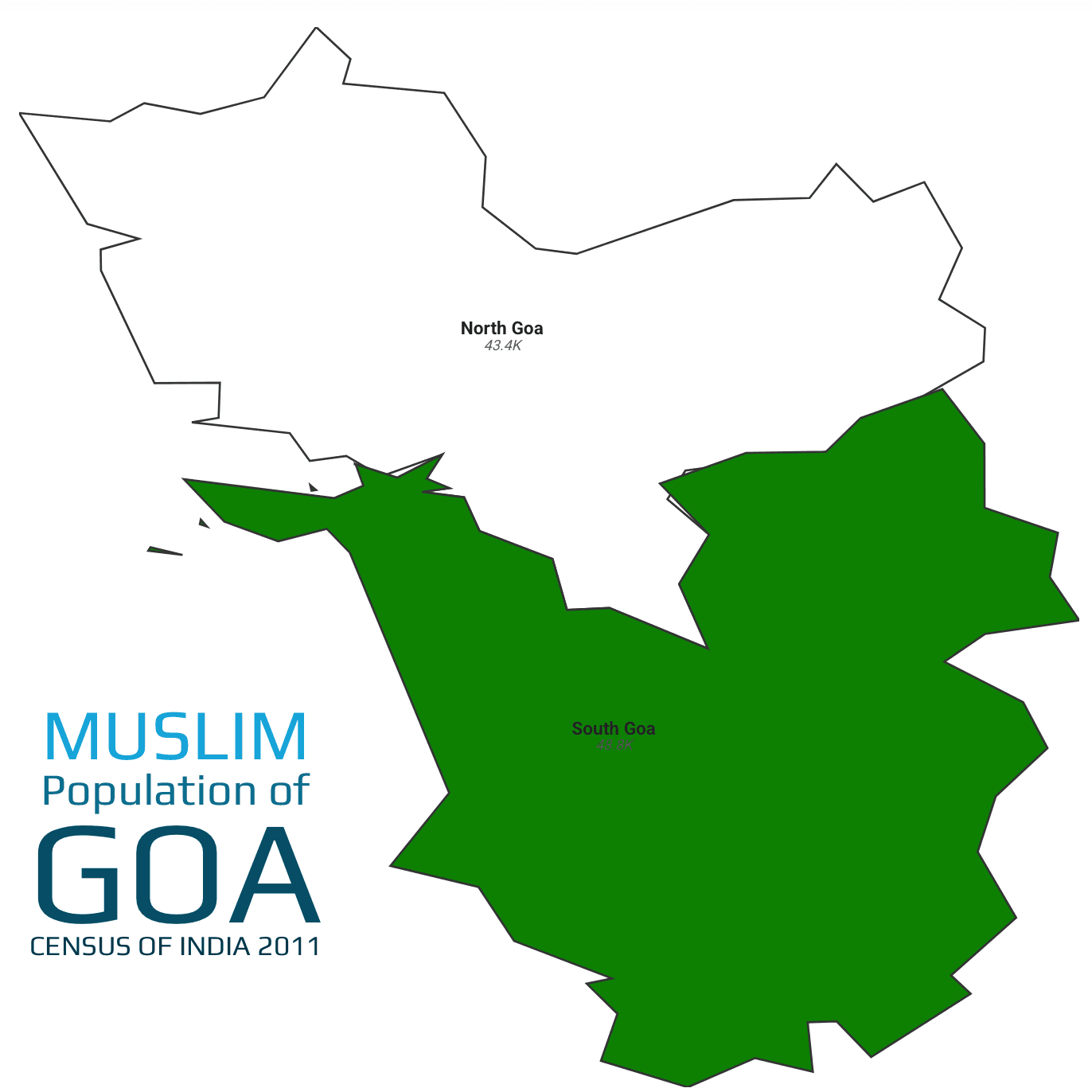
Excerpt: Goa, India’s western coastal gem, is renowned for its beaches, spice plantations, and vibrant tourism-driven economy. Though predominantly Hindu, the state is home to a small but dynamic Muslim community, whose traditions, livelihoods, and social engagement enrich Goa’s multicultural fabric.
According to the 2011 Census, Goa comprises two districts—South Goa and North Goa—with a combined population of 1,347,668, of which 92,210 are Muslims, forming 6.84% of the total[4]. South Goa records the higher share, at 8.3%, while North Goa stands at 5.7%.
Konkani and Marathi are widely spoken across Goa, while Urdu and Arabic script feature in mosque inscriptions and community literature. Goa’s Muslim residents participate actively in tourism, fishing, horticulture, and small-scale trade, with urban pockets showing growing involvement in hospitality and services.
Muslim Population in Goa’s Districts (2011 Census)
South Goa leads with 8.3%, reflecting its historical Arab trade links and plantation communities, while North Goa’s 5.7% presence is rooted in fishing villages and market towns.
Total Muslim vs Non-Muslim Population in Goa (2011 Census)
Muslims account for 6.84% of Goa’s population, with non-Muslims forming the remaining 93.16%. The community contributes to Goa’s service-oriented economy through hospitality, artisanal crafts, and coastal trade.
South Goa: South Goa, with 589,095 residents, includes 48,827 Muslims (8.3%). The coastal district’s economy thrives on tourism, fishing, and spice cultivation; within this, Muslim families run guesthouses, operate backwater cruises, and manage cashew and coconut farms. Community life centers around historic mosques in Margão and Vasco da Gama, with annual festivals like Eid and Milad-un-Nabi drawing both locals and visitors into vibrant cultural fairs, underscoring their integral role in South Goa’s social tapestry.
North Goa: North Goa, home to 758,573 people, counts 43,383 Muslims (5.7%). Renowned for its beaches and heritage towns like Panaji and Mapusa, the district sees Muslim engagement in fishing cooperatives, beachside shacks, and textile vending at local markets. Their social infrastructure includes small madrasas and jaals (community circles), which support religious education and charitable activities. The community balances tradition with tourism-driven enterprise, enriching North Goa’s pluralistic identity.
Muslim Population by District in Goa (2011 Census)
References
- Census of India 2011. Madhya Pradesh Religious Data. [Online] Available at: https://censusindia.gov.in/2011census/C-01.html [Accessed 27 Jul. 2025]
- Minault, Gail. The Bhopal State and Its Rulers, in The Extended Family: Women and Political Participation in India and Pakistan. Oxford University Press.
- NCMEI (National Commission for Minority Educational Institutions): http://ncmei.gov.in/; Sachar Committee Report (2006): http://minorityaffairs.gov.in/sites/default/files/sachar_comm.pdf
- Census of India. C-01: Population by religious community, Goa – 2011. Available at: https://censusindia.gov.in/nada/index.php/catalog/study/PC11_C01-30
Religion
Muslim Population in Telangana (2025 Update): District-Wise Data, Percentage & Analysis
Published
3 months agoon
August 9, 2025Excerpt: Telangana, India’s youngest state formed in 2014, blends rich Nizam heritage, burgeoning IT hubs, and vast rural landscapes. While Hindus form the majority, a substantial Muslim community—rooted in Hyderabad’s historic Old City and spread across urban and rural districts—contributes through trade, culture, and public service, enriching Telangana’s plural fabric.
According to the 2011 Census, Telangana’s total population is approximately 35.19 million, of which about 3.84 million are Muslims, constituting 10.91% of the state’s population[5][6]. The Muslim population is concentrated in Hyderabad, Nizamabad, and other northern and central districts.
Telugu is the dominant language, with Urdu prominent among Muslim communities, especially in Hyderabad and Nizamabad. Urban districts show higher Muslim participation in IT, education, and services, while rural districts engage in agriculture, small trade, and local crafts.
Top 10 Districts by Muslim Population in Telangana
Hyderabad (43.45%) leads with the highest Muslim proportion, reflecting its historic Deccan sultanate legacy. Northern districts like Nizamabad (18.52%), Sangareddy (16.15%), and Nirmal (14.04%) also exhibit significant Muslim shares, influenced by medieval trade routes and Nizam administration.
Districts like Jayashankar Bhupalpally (2.95%) and Jangaon (3.19%) have the lowest Muslim shares, reflecting limited historical settlement. Central districts such as Peddapalli (6.03%) and Khammam (6.05%) also show lower proportions due to agrarian economies and fewer urban centers.
Total Muslim vs Non-Muslim Population in Telangana (2011 Census)
Muslims constitute 10.91% of Telangana’s population, while non-Muslims form 89.09%, highlighting a distinct minority concentrated in urban and selected rural districts.
Muslim vs Hindu Population in Telangana (2001 & 2011 Census)
Between 2001 and 2011, Telangana’s Muslim population rose nearly 20%, outpacing Hindu growth of 9.4%, driven by urban migration into Hyderabad and natural growth in northern districts[7]
Districts with Highest Muslim Density per 100,000 People in Telangana
Hyderabad and Sangareddy display the highest Muslim densities, reflecting dense urban settlements and peri-urban expansion influenced by the IT corridor and historic city growth.
Small Population Districts with Low Muslim Percentage
Mulugu, Jayashankar Bhupalpally, and Jangaon are smaller districts with under 4% Muslim presence, shaped by tribal demographics and minimal historic influx.
Adilabad (12.58%): Adilabad, population 708,972, has 89,208 Muslims. Bordering Maharashtra, its tribal and forestry economy contrasts with Muslim engagement in small‐scale trade, transportation, and leather crafts. Hyderabad State-era administrative centers left Urdu‐speaking enclaves. Weekly markets in Adilabad town and urban clusters foster Muslim–Hindu interactions, with local mosques serving as cultural hubs during Ramadan and Eid festivals.
Bhadradri Kothagudem (5.62%): With 1,115,724 residents and 62,672 Muslims, Kothagudem’s coal and power industries draw Muslim workers in mining, logistics, and utilities. Settlements around Kothagudem town see mosques integrated into cityscapes. Community life revolves around Urs festivals at local dargahs, while rural pockets maintain lower proportions owing to tribal majorities and agrarian livelihoods.
Hyderabad (43.45%): Hyderabad’s 3,943,323 residents include 1,713,405 Muslims, the highest share regionally, rooted in centuries of Qutb Shahi and Asaf Jahi rule. The Old City thrives on bazaars, pearl trade, and charminar-era heritage. Today, Muslims excel in government service, education, and small‐scale industries. Iconic mosques like Mecca Masjid anchor vibrant religious life, while modern institutions nurture socio‐economic mobility.
Jagtial (7.78%): Jagtial, with 988,913 population and 76,952 Muslims, centers on rice mills and oil extraction. Muslim communities cluster in Jagtial town, engaging in milling businesses, transport, and trade. Mosques and Urdu-medium schools provide religious and linguistic education. While agrarian rhythms dominate, urbanization brings better healthcare and schooling for the minority community.
Jangaon (3.19%): Jangaon’s 561,422 people include only 17,899 Muslims. A small district carved from Warangal, its rural economy—cotton, paddy, and cattle—provides limited opportunities for Muslims. Most work in small shops, driving transport services, or as seasonal laborers. Communal ties revolve around a few mosques in Jangaon town, strengthening identity amid Hindu‐majority villages.
Jayashankar Bhupalpally (2.95%): With 410,963 residents and 12,130 Muslims, Bhupalpally’s tribal forests and coalfields host a tiny Muslim presence. Predominantly agrarian, Muslims here engage in manual labor, small retail, and transport. Limited infrastructure confines them to Bhupalpally town clusters. Mosques serve scant congregations, reflecting a community navigating marginal footholds.
Jogulamba Gadwal (7.96%): Gadwal’s 609,990 population includes 48,557 Muslims engaged in textile weaving, rice trade, and peri‐urban services. Famous for Gadwal sarees, local Muslim weavers sustain historic crafts alongside Hindu artisans. Community festivals blend seamlessly, with Eid and Diwali celebrated in shared public spaces, reinforcing social cohesion.
Kamareddy (10.22%): Kamareddy, home to 974,227 people including 99,572 Muslims, straddles Hyderabad’s rural fringe. Agriculture and granite mining define its economy, with Muslims working as traders, quarry supervisors, and transporters. Mosques in Kamareddy town anchor communal life, while diaspora networks link to Gulf remittances boosting local development.
Karimnagar (8.63%): Karimnagar’s 983,931 residents include 84,953 Muslims. Known for granite and rice industries, Muslims engage in stone cutting, milling, and trade. Historic forts and mosques in town provide cultural focal points. Muslim madrasa education coexists with secular schools, enhancing literacy and livelihoods in urban and surrounding rural areas.
Khammam (6.05%): Khammam, with 1,545,480 residents and 93,442 Muslims, thrives on coal and cement industries. Muslim laborers and small‐scale entrepreneurs staff factories and shops. Ghats on the Godavari host joint festivals, fostering interfaith ties. Community organizations run health camps and vocational training, promoting socio‐economic upliftment.
Komaram Bheem (Asifabad) (8.11%): Asifabad’s 520,719 people include 42,218 Muslims. Tribal and forested, its small Muslim population works in forestry services, trade, and seasonal labor. Weekly bazaars in Asifabad town unite diverse communities, with mosques serving as both prayer and community centers.
Mahabubabad (3.32%): Mahabubabad’s 754,845 population houses 25,026 Muslims, largely in cotton and mango cultivation areas. Most work as laborers or small‐shop owners in town clusters. Limited mosque infrastructure means communal life centers on private gatherings during Ramadan and Eid.
Mahbubnagar (10.23%): With 1,471,205 residents and 150,453 Muslims, Mahbubnagar balances agriculture, granite mining, and service trades. Muslims run rice mills, transport logistics, and retail shops. Historic mosques in Gadwal and Wanaparthy host vibrant festivals, underscoring long‐standing cultural footprints.
Mancherial (5.60%): Mancherial’s 802,130 people include 44,944 Muslims, many employed in Singareni coal mines and thermal power plants. Labor colonies around mandals foster community bonds, with mosques and madrasas supporting religious education. Seasonal fairs blend tribal and Muslim traditions.
Medak (6.81%): Medak, population 801,131 with 54,549 Muslims, is known for its historic cathedral and regional markets. Muslims here engage in grain trade, weaving, and transport. Urban clusters around Medak town provide better schooling and healthcare, reflected in higher literacy among Muslim youth.
Medchal Malkajgiri (9.24%): As part of the Hyderabad metro, this district’s 2,440,073 residents include 225,377 Muslims. Rapid urban sprawl brings employment in IT parks, manufacturing, and services. Muslim neighborhoods in Sitaphalmandi and Malkajgiri maintain strong community NGOs focused on education and women’s empowerment.
Mulugu (3.35%): Mulugu’s 300,471 people include only 10,064 Muslims, primarily from tribal backgrounds working in forest produce and minor trade. Sparse infrastructure keeps mosques few; communal life centers on home‐based gatherings and itinerant religious teachers.
Nagarkurnool (6.08%): Nagarkurnool’s 662,455 residents include 40,262 Muslims engaged in paddy farming, granite quarries, and small businesses. Mosques in district headquarters serve as community hubs, with modest educational institutions supporting youth development.
Nalgonda (5.79%): Nalgonda’s 1,646,694 people include 95,407 Muslims working in cement plants, agriculture, and local trade. Rural townships host weekly markets blending Hindu and Muslim vendors. Community-led health and literacy camps bolster social integration.
Narayanpet (8.47%): Narayanpet, population 569,942 with 48,286 Muslims, is famous for its handloom saris. Muslim weavers form cooperatives, exporting textiles globally. Cultural festivals patronize joint celebrations, reflecting deep artisanal collaboration.
Nirmal (14.04%): Nirmal’s 709,418 residents include 99,600 Muslims who contribute to famed Nirmal painting, toys, and handicrafts. Muslim artisans work alongside Hindu counterparts, and mosques host community art workshops, promoting cultural synergy.
Nizamabad (18.52%): Nizamabad’s 1,577,108 people include 292,024 Muslims, a legacy of Nizam-era rule. The district’s rice and turmeric markets are dominated by Muslim traders. Historic mosques and dargahs draw pilgrims from across Telangana.
Peddapalli (6.03%): Peddapalli, with 791,836 residents and 47,714 Muslims, hosts coal mines and thermal plants. Muslims here work as laborers, transporters, and small-business owners. Town mosques coordinate vocational training programs for community upliftment.
Rajanna Sircilla (4.03%): Sircilla’s 548,850 people include 22,140 Muslims in textile clusters. Known as the “Manchester of Telangana,” its power looms and dyeing units employ Muslim families. Community centers provide skill training and microfinance support.
Rangareddy (13.62%): Surrounding Hyderabad, Rangareddy’s 2,071,666 residents include 282,120 Muslims engaged in real estate, services, and industry. Rapid urbanization drives diverse employment, while traditional mosques co-exist with modern community halls.
Sangareddy (16.15%): Sangareddy, population 1,495,503 with 241,560 Muslims, thrives on pharmaceutical, textile, and agro-industries. Muslim entrepreneurs lead in turmeric trade and garment manufacturing. Festivals blend rural and urban customs.
Siddipet (5.41%): Siddipet’s 1,023,577 people include 55,408 Muslims in paddy cultivation and granite quarries. Small business clusters in Siddipet town support trade, while mosques host literacy drives and health camps.
Suryapet (5.96%): Suryapet’s 1,144,618 residents include 68,168 Muslims working in textile mills, rice mills, and transport. Community organizations run interfaith events, reinforcing social harmony amid agrarian livelihoods.
Vikarabad (12.94%): Vikarabad’s 946,109 people include 122,448 Muslims, many in horticulture and peri-urban services. Historic forts and mosques attract cultural tourism. Community welfare trusts sponsor education for underprivileged youth.
Wanaparthy (5.91%): Wanaparthy’s 578,329 residents include 34,187 Muslims in paddy and sugarcane farming. Seasonal labor migration to cities supplements incomes. Town mosques facilitate communal gatherings during festivals.
Warangal Rural (3.57%): The rural district’s 759,300 people include 27,120 Muslims, mostly in agriculture and brick kilns. Limited urban centers mean small congregations; religious life revolves around village mosques and itinerant clergy.
Warangal Urban (10.77%): Warangal city’s 1,037,557 residents include 111,763 Muslims. Historic architecture—forts and mosques—attract tourism. Muslims here engage in education, services, and small industries, balancing heritage with modernization.
Yadadri Bhuvanagiri (3.59%): Home to 697,497 people and 25,071 Muslims, Yadadri’s economy centers on pilgrimage tourism and agriculture. Muslim communities serve pilgrims through lodging, transport, and eateries, fostering interfaith engagement.
Muslim Population by District in Telangana (2011 Census)
References
- Census of India 2011. Madhya Pradesh Religious Data. [Online] Available at: https://censusindia.gov.in/2011census/C-01.html [Accessed 27 Jul. 2025]
- Minault, Gail. The Bhopal State and Its Rulers, in The Extended Family: Women and Political Participation in India and Pakistan. Oxford University Press.
- NCMEI (National Commission for Minority Educational Institutions): http://ncmei.gov.in/; Sachar Committee Report (2006): http://minorityaffairs.gov.in/sites/default/files/sachar_comm.pdf
- Census of India. C-01: Population by religious community, Goa – 2011. Available at: https://censusindia.gov.in/nada/index.php/catalog/study/PC11_C01-30
- Census of India. C-17: Primary Census Abstract, Telangana – 2011.
- Government of Telangana. Economic Survey 2012–13. Hyderabad, 2013.
- Government of Telangana. Economic Survey 2012–13. Hyderabad, 2013.
Religion
Muslim Population in Karnataka (2025 Update): District-Wise Data, Percentage & Analysis
Published
3 months agoon
August 8, 2025Excerpt: Karnataka, a state in southwest India known for its technological hubs, silk production, and rich heritage, hosts a significant Muslim community alongside its Hindu majority. Spread across coastal, northern, and central regions, Karnataka’s Muslims contribute to the state’s economy through trade, education, and industry, while preserving cultural traditions in urban and rural settings.
According to the 2011 Census, Karnataka’s total population stands at approximately 61,095,297, of which 7,893,065 are Muslims, forming 12.92% of the state’s population[8][9]
Kannada is the lingua franca, while Urdu remains culturally significant among Muslim communities. Urban centers like Bangalore and Belgaum display higher Muslim engagement in IT, education, and commerce, whereas rural and northern districts rely on agriculture, handicrafts, and small-scale trade.
Top 10 Districts by Muslim Population in Karnataka
The above districts in the chart with the highest share of Muslims in Karnataka show how history, trade, and jobs have shaped the population. Dakshina Kannada (24.02%) is highest due to its coastal trade links with Arab merchants. Gulbarga and Dharwad have high shares because of their Muslim rulers in the past. In places like Haveri, Bijapur, and Raichur, many Muslims work in farming and crafts. In Kodagu and Bellary, they work in plantations and mines. These areas also have strong community institutions.
The above districts in the chart with the lowest Muslim population share in Karnataka are mostly rural and agrarian. Mandya (4.31%) and Chamarajanagar (4.62%) have limited urbanization and smaller Muslim communities engaged in farming and local trade. Districts like Hassan, Chitradurga, and Udupi also have low Muslim presence due to historical Hindu dominance and fewer migration patterns. Bangalore Rural, Tumkur, and Vijaynagara show slightly higher shares due to proximity to cities or mixed economies, but overall, these areas have minimal Muslim cultural influence.
Mandya (4.31%), Chamarajanagar (4.62%), and Hassan (6.76%) record the lowest Muslim proportions, reflecting historic agrarian patterns and limited urbanization.
Total Muslim vs Non-Muslim Population in Karnataka (2011 Census)
Muslims constitute 12.92% of Karnataka’s population, while non-Muslims account for 87.08%, highlighting a notable minority presence across diverse districts.
Muslim vs Hindu Population in Karnataka (2001 & 2011 Census)
Between 2001 and 2011, Karnataka’s Muslim population grew by 22.12%, outpacing Hindu growth of 15.79%, driven by urban migration and higher natural growth in northern and coastal pockets[10]
Districts with Highest Muslim Density per 100,000 People in Karnataka
Coastal Dakshina Kannada and central Dharwad boast the highest Muslim densities, reflecting historic trading hubs and industrial centers.
Small Population Districts with Low Muslim Percentage
Kodagu, Udupi, and Chikmagalur, though smaller in population, maintain below-average Muslim shares, influenced by local agrarian and plantation economies.
Belgaum: With 4,779,661 residents, Belgaum houses 528,412 Muslims (11.06%). Nestled at Karnataka’s northern border, it blends textile, agriculture, and stone-cutting industries. Muslims engage in trade, education, and transport services. The region’s syncretic culture is palpable during Ramadan and Eid gatherings across city mosques and rural madrasas.
Bagalkot: Bagalkot’s 1,889,752 population includes 219,991 Muslims (11.64%). Known for its limestone and agriculture, Muslims here run tile works, shops, and small eateries. Community life centers around local dargahs, with festivals like Urs and Eid drawing devotees from neighboring villages.
Bijapur: Bijapur reports 2,177,331 people, with 369,588 Muslims (16.97%). Famous for its Gol Gumbaz and historical sultanate remnants, the district’s Muslim artisans flourish in stone carving, tailoring, and small-scale tourism. Religious tourism sustains many families, bolstering local markets.
Bidar: Bidar’s 1,703,300 residents include 335,184 Muslims (19.68%), the second-highest share in the state. Renowned for its Bidriware handicrafts, Muslims dominate metal inlay workshops and carpet weaving. Community bonds strengthen during Muharram processions and urs at Sufi shrines.
Raichur: Among 1,928,812 people, Raichur hosts 272,022 Muslims (14.10%). An agrarian district straddling the Krishna River, Muslims engage in paddy cultivation, trade of agricultural inputs, and small transport businesses. Friday prayers in Raichur town unite diverse sub-communities.
Koppal: Koppal’s 1,389,920 population includes 161,770 Muslims (11.64%). With its rich temple architecture and mining sites, the district’s Muslims are employed in service trades, goldsmithing, and local commerce. Communal harmony is evident during shared harvest festivals.
Gadag: Out of 1,064,570 inhabitants, 143,665 are Muslims (13.50%). Gadag’s textile mills and agricultural markets employ many Muslims as traders, weavers, and transporters. Community centers offer madrasas and vocational training, strengthening youth engagement.
Dharwad: Dharwad counts 1,847,023 people, with 386,834 Muslims (20.94%), the highest share in the state. Known for its educational institutions, Muslims participate actively as students and faculty. The district’s cultural festivals showcase Qawwali performances and interfaith music events.
Uttara Kannada: Uttara Kannada’s 1,437,169 population includes 187,974 Muslims (13.08%). Coastal ports and fishing hubs employ Muslims in marine trade, shipbuilding, and fisheries commerce. Eid al-Fitr celebrations see communal feasts along the Arabian Sea coast.
Haveri: With 1,597,668 residents, Haveri has 297,927 Muslims (18.65%). A hub for cotton ginning and oil mills, Muslims here own and operate several agro-based businesses. Friday congregations at historic mosques bind urban and rural congregants alike.
Bellary: Bellary’s 1,300,246 population includes 195,146 Muslims (15.01%). Mining and steel industries attract Muslim labor, entrepreneurs, and traders. Community welfare associations run vocational centers, promoting skill development among youth.
Chitradurga: Among 1,659,456 people, Chitradurga has 128,751 Muslims (7.76%), one of the lower shares. Known for its fortress and granite trade, Muslims run small quarries, tailoring shops, and local eateries. Intercommunity markets foster social cohesion.
Davanagere: Davanagere’s 1,643,494 residents include 237,747 Muslims (14.47%). Known as the “Manchester of Karnataka” for its cotton mills, Muslims engage in textile trading, road transport, and garment manufacturing. Religious schools complement secular education in urban pockets.
Shimoga: Shimoga’s 1,752,753 population hosts 234,664 Muslims (13.39%). With forestry and hydropower projects, Muslims take roles in administration, trade, and service sectors. Eid processions weave through the scenic Tunga River banks.
Udupi: Udupi, with 1,177,361 people, includes 96,740 Muslims (8.22%). A coastal temple town renowned for cuisine, Muslims run seafood businesses, hotels, and pilgrim services. Interfaith dining experiences during Ramadan draw locals and visitors alike.
Chikmagalur: Chikmagalur, with 1,137,961 residents, counts 101,235 Muslims (8.90%). Renowned for its coffee plantations and hill stations, Muslims participate in plantation labor, small-scale hospitality, and café businesses. Local mosques in Kadur and Mudigere host seasonal festivals, while younger generations engage in hospitality and eco‐tourism ventures.
Tumkur: Tumkur’s 2,678,980 population includes 245,923 Muslims (9.18%). An industrially diversified district on the Bangalore highway, Muslims work in manufacturing units, transport logistics, and roadside businesses. Community centers in Tumakuru town provide vocational training and religious education, fostering socio‐economic upliftment.
Bangalore Urban: Karnataka’s capital region, with 9,621,551 people, has 1,248,294 Muslims (12.97%). As an IT and service hub, Muslims excel in professional services, entrepreneurship, and academia. Prominent mosques in Shivajinagar and Frazer Town host major Eid congregations. Community NGOs also run skill‐development and women’s empowerment programs.
Mandya: Mandya’s agrarian landscape of 1,805,769 inhabitants includes 77,801 Muslims (4.31%), the lowest share in the state. Muslims here predominantly engage in livestock rearing, sugarcane trade, and small retail outlets. The community observes collective iftars during Ramadan, strengthening ties with Hindu neighbors.
Hassan: Hassan’s 1,776,421 people encompass 120,011 Muslims (6.76%). Known for its temple architecture and coffee estates, Muslims here manage plantation labor, small hotels, and local transport. Community life revolves around mosques in Hassan city and spiritual gatherings at Urs festivals.
Dakshina Kannada: Home to 2,089,649 residents, including 501,896 Muslims (24.02%), the highest share in Karnataka, this coastal district thrives on fisheries, cashew processing, and port trade. Muslims dominate medium‐scale commerce and logistics in Mangalore. Annual cultural events like Yakshagana include significant Muslim participation.
Kodagu: In Kodagu’s 554,519 population, 87,274 are Muslims (15.74%). Known for coffee and spice plantations, Muslims work as plantation supervisors, café owners, and guides. Community halls in Madikeri host interfaith cultural evenings, reflecting peaceful coexistence.
Mysore: Mysore, with 3,001,127 inhabitants, has 290,549 Muslims (9.68%). Famous for its palace and silk industry, Muslims contribute to silk weaving, power‐loom operations, and tourism services. The annual Mysore Dasara sees Muslim artisans crafting festival paraphernalia alongside Hindu artisans.
Chamarajanagar: Chamarajanagar’s 1,020,791 people include 47,210 Muslims (4.62%). A predominantly rural district near the Tamil Nadu border, Muslims engage in cattle trade, forest produce commerce, and small shops. Friday bazaars in towns like Kollegal facilitate intercultural exchange.
Gulbarga: Gulbarga (Kalaburagi), with 2,566,326 residents, counts 513,125 Muslims (19.99%). A historic Sultanate seat, Muslims here dominate tile manufacturing, brick kilns, and wholesale trade. Religious education flourishes in madrasas, and Sufi shrines draw pilgrims across the Deccan.
Yadgir: Yadgir’s 1,174,271 population includes 155,340 Muslims (13.23%). An agro‐industrial district, Muslims work in rice mills, textile looms, and transport services. Community-driven health camps and literacy programs operate from mosque complexes.
Kolar: Of 1,536,401 inhabitants, 199,873 are Muslims (13.01%). Formerly a gold‐mining hub, today its Muslims run goldsmith workshops, retail jewelry, and agricultural supply stores. Community Eid melas (fairs) foster interreligious harmony in Kolar town.
Chikkaballapura: Chikkaballapura’s 1,255,104 people include 147,810 Muslims (11.78%). Near Bangalore, Muslims engage in dairy production, sericulture, and commuting to urban jobs. Mosque committees here focus on youth mentorship and sports activities.
Bangalore Rural: In the rural periphery of 990,923 people, 92,252 are Muslims (9.31%). Engaged in agriculture, stone quarrying, and peri‐urban services, Muslims commute to Bangalore Urban for work. Community centers offer language classes and microfinance support.
Ramanagara: Ramanagara’s 1,082,636 residents include 114,311 Muslims (10.56%). Known for its silk cocoons and granite quarries, Muslims run cocoon‐trading businesses and stone‐cutting workshops. Interfaith cultural festivals in Ramanagara town bring communities together.
Vijaynagara: Vijaynagara’s 1,454,352 people include 153,746 Muslims (10.57%). A newly formed district with heritage ruins, Muslims here participate in tourism services, agriculture, and local handicrafts. Community youth groups organize educational workshops in Hoovina Hadagalli and Hampi taluks.
Muslim Population by District in Karnataka (2011 Census)
References
- Census of India 2011. Madhya Pradesh Religious Data. [Online] Available at: https://censusindia.gov.in/2011census/C-01.html [Accessed 27 Jul. 2025]
- Minault, Gail. The Bhopal State and Its Rulers, in The Extended Family: Women and Political Participation in India and Pakistan. Oxford University Press.
- NCMEI (National Commission for Minority Educational Institutions): http://ncmei.gov.in/; Sachar Committee Report (2006): http://minorityaffairs.gov.in/sites/default/files/sachar_comm.pdf
- Census of India. C-01: Population by religious community, Goa – 2011. Available at: https://censusindia.gov.in/nada/index.php/catalog/study/PC11_C01-30
- Census of India. C-17: Primary Census Abstract, Telangana – 2011.
- Government of Telangana. Economic Survey 2012–13. Hyderabad, 2013.
- Government of Telangana. Economic Survey 2012–13. Hyderabad, 2013.
- Census of India. C-17: Primary Census Abstract, Karnataka – 2011.
- Centre for Policy Studies. Religious Demography of Karnataka, 2001–11. 2023.
- Centre for Policy Studies. Religious Demography of Karnataka, 2001–11. 2023.

Muslim Population in Goa (2025 Update): District-Wise Data, Percentage & Analysis

Muslim Population in Telangana (2025 Update): District-Wise Data, Percentage & Analysis

Muslim Population in Karnataka (2025 Update): District-Wise Data, Percentage & Analysis

Trump’s 2025 Tariffs on India Explained: Full List, Dates, Products, and 50% Duty Impact

Muslim Population in Odisha (2025 Update): District-Wise Data, Percentage & Analysis

Muslim Population in Goa (2025 Update): District-Wise Data, Percentage & Analysis

Muslim Population in Telangana (2025 Update): District-Wise Data, Percentage & Analysis

Muslim Population in Karnataka (2025 Update): District-Wise Data, Percentage & Analysis
Trending

 Economy2 years ago
Economy2 years agoWhy Pakistan’s economy is drowning while India’s economy is touching the sky

 Technology2 years ago
Technology2 years agoHighest number of software developers by country in the world 2023 by GitHub | Data Player

 Religion1 year ago
Religion1 year agoMapped: What are the muslims population in Uttar Pradesh | State of India

 Demographics1 year ago
Demographics1 year agoMapped: Average Working Hours by European Countries in 2024

 Demographics2 years ago
Demographics2 years agoWhat are the Number of Villages in India by its State and Union Territory

 Superpower countries1 year ago
Superpower countries1 year agoGlobal Nuclear Warhead Distribution by Nation 2024

 Demographics2 years ago
Demographics2 years agoMassive population size by Indian states 2023

 Religion1 year ago
Religion1 year agoMapped: What is Muslim Population in West Bengal by District wise 2011
